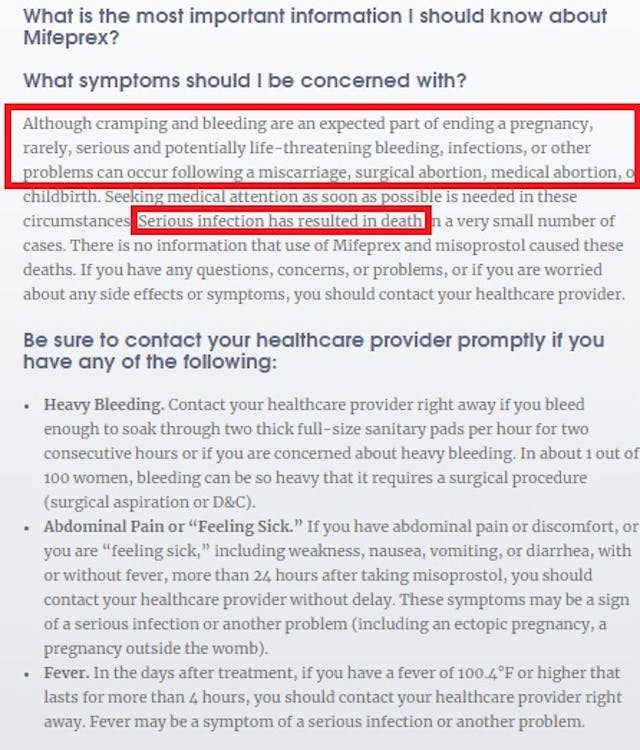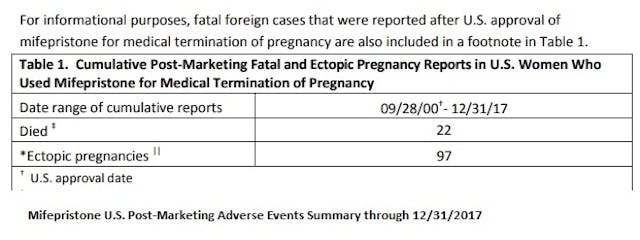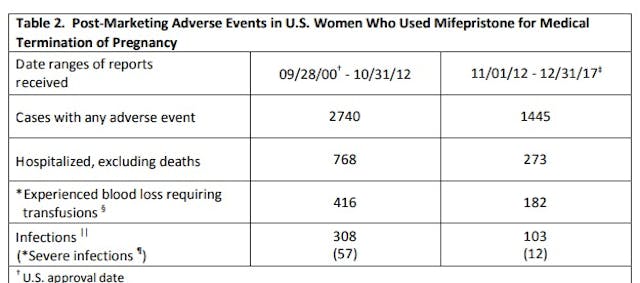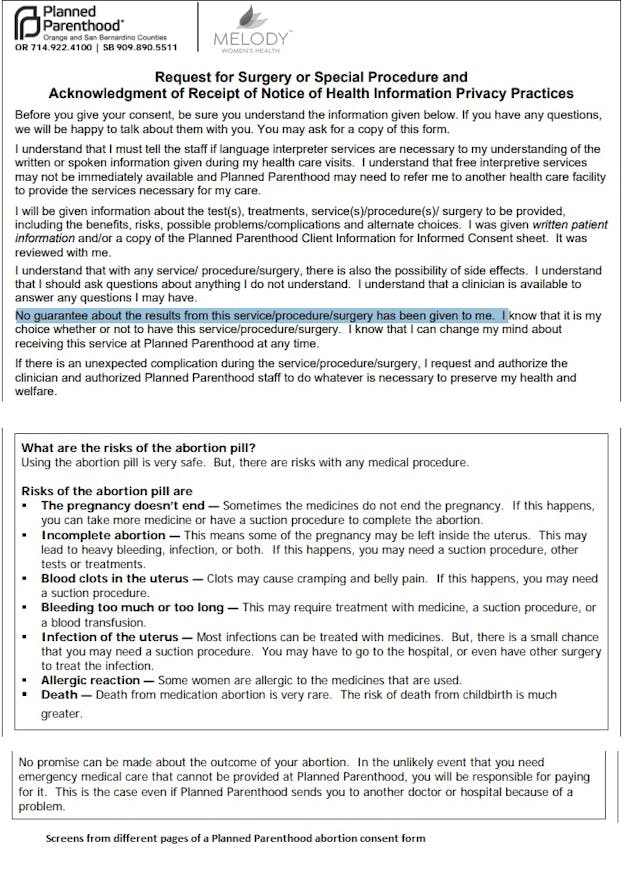
Before a confirmed spina bifida diagnosis, a nurse and doctor pressured her to abort
Unplanned Stories
·
Abortion Pill·By Carole Novielli
FDA shock: Abortion pill caused 22 deaths and a thousand hospitalizations
At least 22 women have died after taking the abortion pill regimen, RU-486, and many others have experienced serious complications, according to updated data from the Food and Drug Administration (FDA). While abortion — and specifically, medication abortion — is sold to women as “safe,” there can be serious and life threatening complications from the abortion pill, as noted by the pills’ manufacturer, Danco. Although Danco is required to report any death associated with Mifeprex, women experiencing complications, various factors — such as not returning to the abortion provider or not reporting use of the drug to emergency personnel — may cause these numbers to seem lower than they actually are.
The abortion lobby is pushing for easy access to the abortion pill on college campuses and some are even calling for it to be approved for home use. No doubt, we may never know how many women suffer serious complications or succumb to death from the abortion pill if this happens. Clearly, according to its manufacturer, there are serious risks:

The abortion inducing regimen is made up of two pills, Mifeprex (mifepristone) and misoprostol, which, according to the FDA, will end “an early pregnancy (70 days or less since the first day of the last menstrual period).” Of course, “the pregnancy” is a term for ending the life of a preborn child in the womb. But, sometimes these chemicals also claim the lives of their mothers. The abortion is explained by Dr. Anthony Levatino in the video below:

Monte Patterson, the father of Holly Patterson, attempted to convey the dangers of the abortion pill before a House committee in 2006, when far fewer women had died. Holding a picture of his daughter, Monte described to that committee the tragic way Holly died after being given the drug at Planned Parenthood.

“I wanted to show you a picture of my daughter so at least you see what I have lost… Holly, who died at 18, and the other women who have died or have been seriously hurt by taking the RU-486 medical abortion drug regimen as a solution to their unplanned pregnancy, ” Mr. Patterson said.
He told the committee:
Twelve days after Holly’s 18th birthday, on September 10, 2003, she walked into a Planned Parenthood clinic to be administered an RU-486 medical abortion regimen. By the 4th day, she was admitted to the emergency room…. She complained of bleeding, cramping, constipation, and pain, but subsequently, she was sent home. Seven days after taking RU-486, Holly returned to the same emergency room hospital complaining of weakness, vomiting, abdominal pain.
Hours later, I was called to the hospital, where I found her surrounded by doctors and nurses, barely conscious and struggling to breathe. Holly was so weak she could barely hold onto my hand…. I watched Holly succumb to a massive bacterial infection as a result of a drug-induced abortion with RU-486….
Article continues below
Dear Reader,
In 2026, Live Action is heading straight where the battle is fiercest: college campuses.
We have a bold initiative to establish 100 Live Action campus chapters within the next year, and your partnership will make it a success!
Your support today will help train and equip young leaders, bring Live Action’s educational content into academic environments, host on-campus events and debates, and empower students to challenge the pro-abortion status quo with truth and compassion.
Invest in pro-life grassroots outreach and cultural formation with your DOUBLED year-end gift!
In 2005, the journal Contraception published a letter from Dr. Philip Darney, who claimed the death rate from medication abortion among Planned Parenthood patients, at that time, was “1.5 per 100,000 compared to a US rate of .5 for early surgical abortion.” Darney is no pro-lifer, and has served on the boards of Planned Parenthood Federation of America and the Guttmacher Institute, Planned Parenthood’s former research arm.

In his letter, Darney pointed out that the US death rate using the abortion pill was higher than in Europe, possibly because, in the states, “US Physicians do not follow the FDA approves instructions for using both drugs…. Instead, they rely on evidence based protocols….”
Currently, according to the FDA, as of December 31, 2017, there have been reports of 22 deaths associated with the abortion pill regimen and several cases of severe systemic infection (also called sepsis), including some that were fatal.

In addition to deaths, between 2000 and 2012, numerous serious complications were also reported:
Cases with any adverse event – 2740 (average 228/yr)
Hospitalized, excluding deaths – 768 (average 64/yr)
Experienced blood loss requiring transfusions – 416 (average 35/yr)
Infections – 308 (average 26/yr)

Within the past five years (between 2012 and 2017) complication reports from the abortion pill have remained steady:
Cases with any adverse event – 1445 (average 289/yr)
Hospitalized, excluding deaths – 273 (average 55/yr)
Experienced blood loss requiring transfusions – 182 (average 36/yr)
Infections – 103 (average 21/yr)
In one state alone — Ohio — complications from the abortion pill have increased an astronomical 87 percent since 2014.
Planned Parenthood and the abortion industry present abortion as “safe and simple,” but one look at forms they require women to sign reveals the real truth. Missed abortion, blood clots, infection and even death are among the risks associated with medication abortion.

Live Action News is pro-life news and commentary from a pro-life perspective.
Contact editor@liveaction.org for questions, corrections, or if you are seeking permission to reprint any Live Action News content.
Guest Articles: To submit a guest article to Live Action News, email editor@liveaction.org with an attached Word document of 800-1000 words. Please also attach any photos relevant to your submission if applicable. If your submission is accepted for publication, you will be notified within three weeks. Guest articles are not compensated (see our Open License Agreement). Thank you for your interest in Live Action News!

Unplanned Stories
·
Abortion Pill
Carole Novielli
·
Abortion Pill
Carole Novielli
·
Abortion Pill
Bridget Sielicki
·
Abortion Pill
Carole Novielli
·
Abortion Pill
Bridget Sielicki
·
Abortion Pill
Carole Novielli
·
Investigative
Carole Novielli
·
Abortion Pill
Carole Novielli
·
Investigative
Carole Novielli
·
Human Rights
Carole Novielli
·